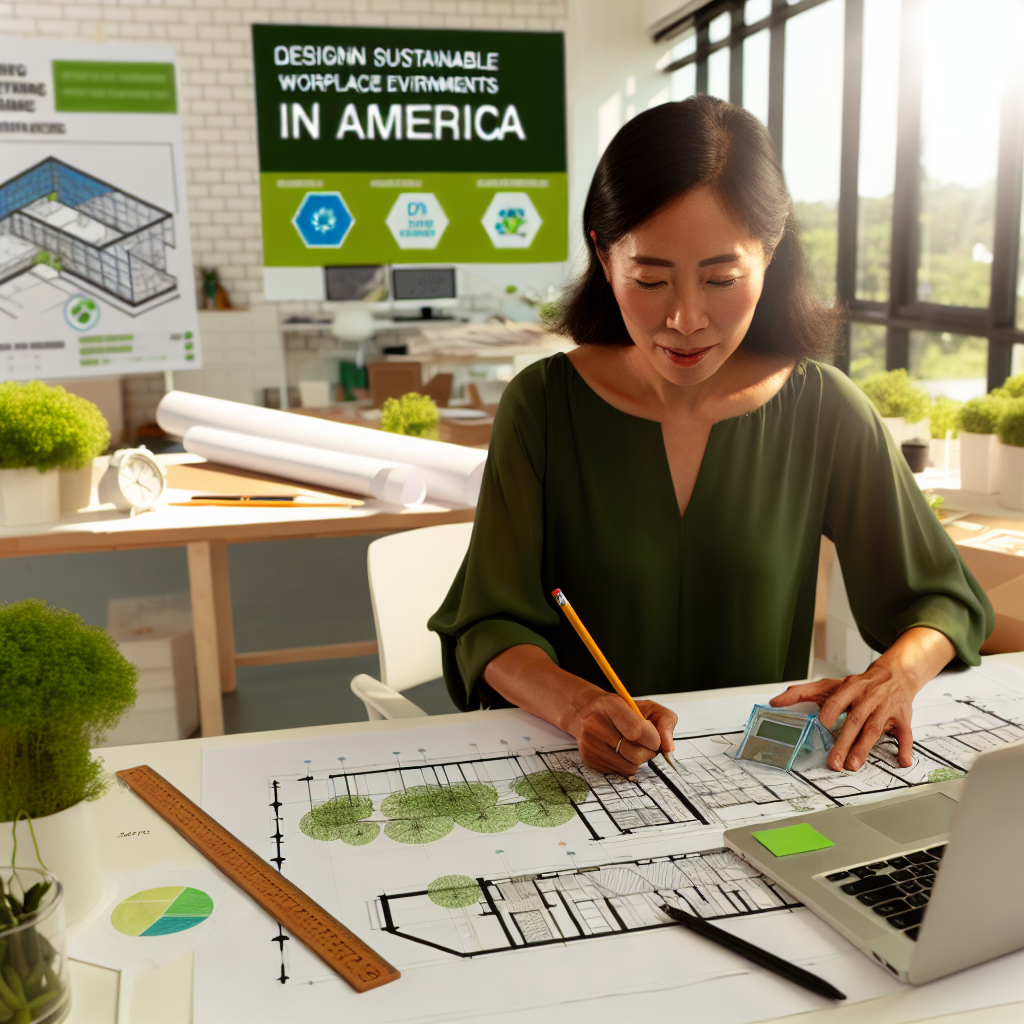Integration of Biophilic Design Elements in Office Spaces
Understanding Biophilic Design
Biophilic design emphasizes the connection between nature and people.
It aims to create environments that enhance well-being and productivity.
This design philosophy integrates natural elements into built spaces.
It includes features like plants, natural light, and organic materials.
The Benefits of Biophilic Design
Integrating biophilic elements improves employee mood and satisfaction.
Research shows that people feel more relaxed in nature-inspired spaces.
Such environments boost creativity and cognitive function significantly.
Moreover, they enhance indoor air quality, contributing to overall health.
Key Elements of Biophilic Design
Natural light is a crucial aspect of biophilic design.
Large windows and skylights allow daylight to fill workspaces.
Indoor plants are vibrant additions that purify air and uplift spirits.
Water features create soothing sounds that reduce stress levels.
Using natural materials like wood and stone promotes a warm atmosphere.
Implementing Biophilic Design in Modern Offices
Companies should assess their existing spaces for integration opportunities.
Start by introducing indoor plants in common areas and workstations.
Next, consider open layouts that allow natural light to penetrate.
Incorporate nature-themed artwork to create a more inviting environment.
Additionally, providing outdoor workspaces can enhance employee well-being.
Case Studies of Successful Biophilic Design
Many companies have embraced biophilic design with outstanding results.
For instance, tech giant Google features gardens within its campuses.
This initiative has greatly enhanced employee morale and productivity.
Another example is the restructuring of Herman Miller’s offices.
They utilized natural materials and plants, resulting in increased employee engagement.
Utilization of Sustainable Materials in Office Furniture and Construction
Importance of Sustainable Materials
Sustainable materials play a crucial role in modern office design.
They reduce the carbon footprint of buildings and furniture.
Moreover, they promote a healthier indoor environment for employees.
Using these materials demonstrates corporate social responsibility.
Types of Sustainable Materials
Reclaimed wood is a popular choice for office furniture.
It offers a unique aesthetic while reducing waste.
Recycled metal is also frequently used in construction.
It is durable and minimizes the need for new resource extraction.
Cork serves as an excellent flooring option.
It is renewable and provides natural insulation.
Benefits of Sustainable Office Furniture
Sustainable furniture enhances the overall work experience.
Employees often feel more comfortable and valued.
Additionally, such furniture can improve productivity.
Studies show that a healthier workplace increases employee satisfaction.
Challenges and Considerations
While sustainable materials are beneficial, challenges remain.
Finding reliable suppliers who prioritize sustainability can be difficult.
Moreover, initial costs may be higher than traditional materials.
However, the long-term benefits often outweigh these concerns.
Examples of Companies Leading the Way
Companies like Steelcase and Herman Miller set the standard.
They focus on creating environmentally friendly office solutions.
Additionally, local businesses are adopting these practices.
By doing so, they contribute to community sustainability efforts.
Impact of Flexible Workspaces on Employee Well-being and Productivity
Enhancing Work-Life Balance
Flexible workspaces allow employees to choose their work environment.
This autonomy fosters a better work-life balance.
Consequently, employees experience reduced stress levels.
Moreover, they can manage personal responsibilities more efficiently.
Boosting Engagement and Collaboration
Open and adaptable office spaces encourage interaction among employees.
This setup boosts teamwork and collaboration across departments.
As a result, employees feel more engaged and connected to their work.
Furthermore, they often exchange ideas more freely.
Improving Physical and Mental Health
Incorporating wellness areas in office designs benefits employee health.
Relaxation zones promote breaks, enhancing focus and creativity.
Additionally, access to natural light positively affects mood.
This aspect contributes to overall mental well-being.
Fostering Productivity
Flexible workspaces can significantly enhance productivity levels.
Tailoring work environments to individual needs optimizes performance.
Employees report higher satisfaction when they can choose their settings.
Ultimately, companies benefit from improved output and reduced turnover.
Encouraging Sustainability Practices
Flexible workspaces often incorporate sustainable design elements.
These features promote environmental responsibility among employees.
Thus, creating a culture that values sustainability becomes achievable.
Employees feel proud to work in eco-friendly environments.
Discover More: The Role of Sustainability in Modern Office Space Design
Role of Smart Technology in Enhancing Energy Efficiency in Offices
Introduction to Smart Technology
Smart technology plays a vital role in modern office design.
It integrates digital tools to optimize energy consumption.
This integration significantly boosts overall efficiency.
Smart Lighting Systems
Smart lighting systems adjust intensity based on occupancy.
These systems reduce energy waste when spaces are unoccupied.
Moreover, they can adapt to natural light levels.
This feature further enhances energy efficiency.
Energy Management Systems
Energy management systems provide real-time monitoring.
They allow companies to track their energy usage effectively.
As a result, businesses can identify wasteful practices.
These systems help set benchmarks for energy savings.
Automation and AI
Automation streamlines building operations to save energy.
AI analysis can predict energy needs based on usage patterns.
This feature ensures optimal functioning of HVAC systems.
Consequently, energy consumption is minimized, leading to savings.
Benefits of Implementing Smart Technology
Implementing smart technology improves workplace comfort.
Employees experience a more pleasant environment.
In addition, companies often see reduced operational costs.
Smart technology supports sustainability initiatives, enhancing brand reputation.
See Related Content: How To Increase The Value Of Your Industrial Real Estate Portfolio
Design Strategies for Improving Indoor Air Quality
Incorporating Biophilic Design
Biophilic design connects people with nature in the workplace.
Including natural elements enhances air quality and employee well-being.
Plants filter pollutants and release oxygen, creating fresher air.
Furthermore, they reduce stress and improve focus among employees.
Utilizing Advanced Ventilation Systems
Modern ventilation systems play a crucial role in indoor air quality.
They continuously circulate fresh air throughout the workspace.
Incorporating energy recovery ventilators minimizes energy loss.
This approach ensures consistent airflow while conserving energy.
Implementing Smart Monitoring Technology
Smart monitors provide real-time data on indoor air quality.
Adjusting systems based on data improves overall air conditions.
Such technology enhances employee comfort and productivity.
Additionally, it aids facility managers in identifying issues promptly.
Selecting Low-VOC Materials
Choosing low-VOC (volatile organic compounds) materials is essential.
These materials reduce harmful emissions throughout the office.
Options include low-VOC paints, adhesives, and furniture.
Implementing these choices promotes safer working conditions.
Enhancing Natural Light Exposure
Natural light significantly affects indoor air quality and well-being.
Designing spaces with ample windows boosts mood and reduces fatigue.
It also limits the need for artificial lighting, lowering energy use.
Overall, brighter spaces enhance both air quality and productivity.
Creating Designated Relaxation Zones
Relaxation zones encourage employees to take breaks effectively.
These areas can include plants, natural light, and reduced noise levels.
Such environments help in lowering stress and improving air quality.
Moreover, they foster creativity and collaboration among team members.
Uncover the Details: How to Evaluate Commercial Real Estate for Long-Term Growth Potential

The Rise of Remote Work and Its Effect on Traditional Office Layouts
The Shift to Remote Work
Remote work has surged in popularity over recent years.
Many companies now offer flexible work arrangements.
This shift has changed how we think about office spaces.
Employees appreciate the benefits of working from home.
Consequently, traditional office layouts are being re-evaluated.
Impact on Office Design
Companies are scaling down their office footprints.
Open-plan offices are becoming less common.
Collaborative spaces are now prioritized in design.
Employees seek environments that foster creativity and teamwork.
As a result, offices are evolving to accommodate these needs.
Emphasis on Flexibility
Modern workplaces now focus on adaptability.
Modular furniture allows for reconfiguration easily.
Meeting rooms can transform based on project requirements.
This flexibility supports various work styles.
Moreover, companies can adjust layouts as teams grow or shrink.
Health and Wellbeing Considerations
Health and wellbeing have become top priorities in office design.
Natural light and green spaces enhance employee satisfaction.
Additionally, ergonomic furniture reduces the risk of injury.
Well-designed spaces contribute to mental health and productivity.
Companies are increasingly aware of the need for wellness initiatives.
Technology Integration
Technology plays a vital role in modern office spaces.
Smart office solutions enhance connectivity and efficiency.
Integrated systems streamline communication among remote and in-office teams.
With advanced tools, collaboration becomes seamless.
This technology-focused approach ensures everyone stays connected.
Adapting Traditional Office Layouts
The rise of remote work has fundamentally changed office design.
Modern workplaces must now adapt to new realities.
Flexibility, wellbeing, and technology integration drive new layouts.
Consequently, businesses must embrace these changes to succeed.
Delve into the Subject: The Pros And Cons Of Converting Industrial Space Into Mixed-Use
Incorporating Wellness Amenities to Promote Healthy Work Environments
Importance of Wellness Amenities
Wellness amenities play a crucial role in modern office design.
They contribute to employee satisfaction and productivity.
Furthermore, such amenities help reduce stress levels among employees.
Examples of Wellness Amenities
Employers increasingly implement fitness facilities within their offices.
On-site gyms offer employees convenient access to exercise.
Additionally, relaxing areas with comfortable seating invite breaks.
These spaces allow employees to recharge during busy workdays.
Incorporating Nature into Workspaces
Integrating nature into office environments enhances well-being.
Biophilic design features introduce natural elements to indoor spaces.
For instance, indoor plants improve air quality and mood.
Natural light also influences energy levels and overall happiness.
Creating Mindfulness Zones
Designing mindfulness zones can greatly benefit employees.
Quiet areas facilitate meditation and relaxation during hectic days.
Employers can furnish these spaces with calming decor and resources.
Such zones promote mental clarity and focus.
Wellness Amenities Impact on Business Performance
Incorporating wellness amenities is essential for sustainable office design.
They foster a healthier and more engaged workforce.
Ultimately, this leads to improved overall business performance.
Future Trends in Collaborative Spaces and Team Dynamics
Importance of Flexible Workspaces
Flexible workspaces enhance team collaboration and creativity.
They provide a dynamic environment that adapts to changing needs.
As teams grow, their workspace must evolve in response.
This trend also promotes a sense of ownership among employees.
Additionally, it fosters a culture of innovation and engagement.
Integration of Technology
Technology plays a crucial role in shaping office design.
Smart office solutions enhance communication and productivity.
These innovations include video conferencing and interactive displays.
Furthermore, they allow seamless connection among remote team members.
Cutting-edge tools transform traditional workspace concepts.
Focus on Health and Well-being
Designing for employee well-being is now a priority.
Incorporating natural light positively affects mental health.
Green spaces within the office promote relaxation and focus.
Moreover, ergonomic furniture supports physical comfort.
This holistic approach boosts overall workplace satisfaction.
Encouraging Collaboration Through Design
Collaboration zones facilitate spontaneous interactions.
These spaces encourage brainstorming and rapid problem-solving.
Breakout areas provide informal settings for team discussions.
Incorporating diverse seating arrangements inspires creativity.
Additionally, colorful designs can boost morale and stimulate ideas.
Sustainability in Office Design
Sustainable materials and practices are becoming standard.
Companies are prioritizing eco-friendly furnishings and resources.
Green certifications for buildings signify a commitment to sustainability.
This trend resonates with environmentally conscious employees.
Ultimately, sustainable practices contribute to global well-being.




